A vent cover, also known as an air vent cover or ventilation cover, is a protective covering that goes over a ventilation opening in a building. Vent covers serve several important functions:
Page Contents
Protecting the Ventilation System
Vent covers prevent debris, animals, insects, and other foreign objects from entering the ventilation system through the vents. Items that make their way into ventilation ductwork can damage fans, clog up the system, or get blown into interior spaces. Vent covers act as a barrier to keep out anything that could potentially interfere with proper air circulation.
Regulating Airflow
Many vent covers contain adjustable openings or louvers that allow for control over the amount of airflow. This helps balance ventilation and prevents spaces from becoming too drafty or stagnant. Vent covers with adjustable features are especially useful on powerful ventilation systems that move high volumes of air very quickly.
Blending in Aesthetically
Vent covers allow vents to blend in with the surrounding interior design rather than standing out as an eyesore. Vent covers come in a wide range of colors and finishes to match any decorative scheme. There are also vent covers designed to coordinate with specific types of flooring, moldings, and other details.
Types of Vent Covers
There are several different types of vent covers suited for various applications:
Wall Vent Covers
Wall vent covers are the most common type. They are designed to fit over vents located in walls and have a low profile that sits flush against the wall surface.
Ceiling Vent Covers
For vents situated in ceilings, ceiling vent covers are necessary. They are typically rectangular or squareshaped to fit standard ceiling vent dimensions.
Floor Vent Covers
Vents placed in floors require specialized floor vent covers. These covers are durable enough to handle foot traffic and weight.
Range Hood Vent Covers
Above stoves, a range hood vent requires a cover that is heat-resistant. Stainless steel is a common material for range hood vent covers.
Bathroom Vent Covers
Bathroom vent covers have moisture-resistant properties to handle the humid environment. Many also have a backdraft damper to prevent air from flowing back into the bathroom.
Dryer Vent Covers
To deal with the large amounts of warm, moist air from clothes dryers, dryer vents need covers made from corrosion-resistant metals like aluminum or stainless steel.
Materials for Vent Covers
Vent covers come in a variety of different materials, each with their own properties, advantages, and disadvantages:
| Material | Properties | Advantages | Disadvantages |
|---|---|---|---|
| Plastic | Durable, mold/mildew resistant, affordable | Lightweight, easy to clean, variety of colors/finishes | Can warp over time, prone to scratching, not for floor vents |
| Metal | Strong, holds up to impact, rust resistant | Sturdy, maintains shape, durable finishes | Can dent, conducts heat/cold, needs occasional repainting |
| Wood | Natural material, easily painted/stained | Matches existing wood trim, renewable resource | Warps, scratches easily, not moisture resistant |
| Polycarbonate | Very strong, temperature/impact resistant | Nearly unbreakable, good for floor vents | Expensive, limited color/finish options |
Key Features of Vent Covers
There are several key features to evaluate when selecting a vent cover:
Material
As described above, the material affects durability, appearance, and suitability for the location.
Style
Vent covers come in many styles: rectangular, round, oval, square, discrete/decorative, classic register, etc. Choose a style that matches the room.
Finish
Select a finish that coordinates with the room’s decor – painted, natural, brushed, polished, oiled, and more.
Adjustability
Look for adjustable louvers, dampers, or blocks if you need to control airflow.
Size
Measure the vent dimensions to find a cover that fits properly. An undersized cover will look sloppy and leak air.
Quality
Higher quality vent covers last longer and have better performance. Examine materials, construction and brand reputation.
How to Measure for a Vent Cover
Follow these steps to measure your vent accurately so you can find the right sized cover:
- Remove the existing vent cover if possible.
- Use a tape measure to measure the width and height of the vent opening in inches.
- For a rectangular vent, measure both the inside and outside dimensions.
- Record the measurements to bring to the hardware store.
- Measure any screw holes for the mounting brackets.
- Note the depth of the vent if purchasing a deep-fitted cover.
- Measure the distal slats on adjustable vent covers.
- For floor vents, measure the thickness and diameter/length as well.
How to Install a Vent Cover
Follow these basic steps for proper vent cover installation:
- Clean dirt, dust and debris from the existing vent and surrounding area.
- Remove the old cover if there is one.
- Place the new vent cover over the opening.
- Insert any screws, bolts or fasteners and tighten them.
- Make sure the cover sits flush and is properly aligned.
- Check that adjustable openings function properly.
- Snap plastic covers into place as needed.
- Caulk around the edges of the cover with silicone sealant.
- Paint the cover if needed to match the color of the wall/ceiling.
Conclusion
Vent covers, or air vent covers, protect ventilation openings and enable control over airflow. They come in many types, materials, styles and sizes. Carefully measure your existing vent to find the right replacement cover. Install the new vent cover securely using the proper fasteners and sealant to prevent air leaks. With the right vent cover installed, your ventilation system will stay clean and function properly.
